Physical Address
304 North Cardinal St.
Dorchester Center, MA 02124
Physical Address
304 North Cardinal St.
Dorchester Center, MA 02124
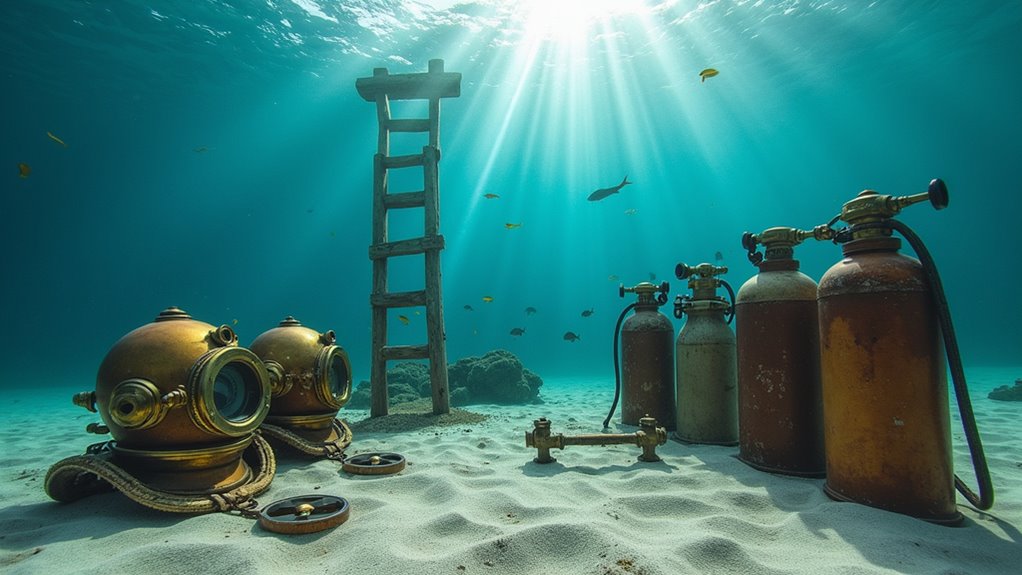
Knowing scuba diving's dangerous origins—from ancient breath-holders to military experiments—reveals why your modern gear exists and transforms your underwater adventures.
When you watch Jacques Cousteau’s documentaries, you’re witnessing the legacy of centuries of underwater innovation. You’ll discover that modern scuba diving didn’t emerge overnight—it’s built on ancient breath-holding techniques, military necessity, and brilliant inventors who risked their lives testing primitive equipment. Understanding this rich history won’t just satisfy your curiosity; it’ll transform how you approach diving today. There’s a surprising connection between those early pioneers and the gear you trust underwater.
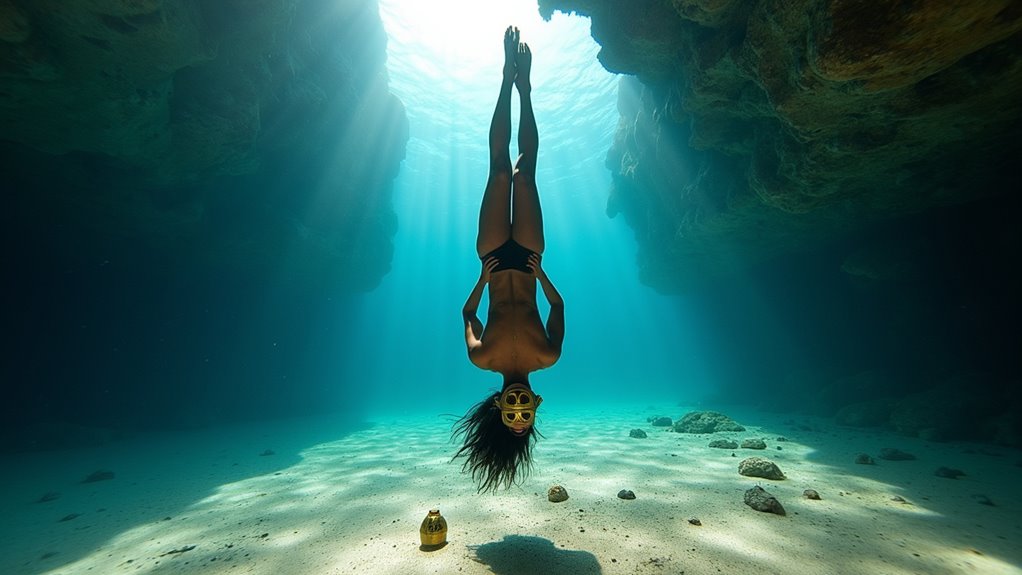
Long before modern scuba gear existed, humans were already pushing the boundaries of underwater exploration through sheer determination and breath-holding mastery. You’ll find that ancient civilizations developed sophisticated diving techniques out of necessity.
Greek sponge divers could descend 100 feet using only weighted stones, while Japanese ama divers perfected breathing methods that allowed them to harvest pearls and seaweed for extended periods underwater.
Ancient divers mastered remarkable feats of endurance, descending to incredible depths armed with nothing but weighted stones and perfected breathing techniques.
These early pioneers didn’t just hold their breath – they mastered hyperventilation techniques and used tools like breathing tubes made from reeds. You’d be amazed how Pacific Islander pearl divers could stay submerged for several minutes, charting coral reefs with remarkable skill.
Their cultural traditions passed down diving wisdom through generations, laying the groundwork for today’s underwater exploration techniques. Just as modern adventurers combine different outdoor pursuits, these ancient divers often paired their underwater skills with rock climbing abilities to access remote coastal diving spots from cliff faces.
Five centuries before modern scuba equipment, Leonardo da Vinci sketched designs that would revolutionize underwater exploration forever. You’ll find his diving bell concepts in his notebooks from the 1480s, featuring leather suits connected to breathing tubes and flotation devices.
Da Vinci understood that you’d need continuous air supply for extended underwater work, so he designed systems using bellows and air chambers.
His sketches show remarkable foresight—he planned snorkel-like breathing apparatus and even considered using pig bladders as primitive air tanks. You can see how da Vinci anticipated problems that wouldn’t be solved for centuries.
While his designs weren’t built during his lifetime, they laid vital groundwork for future inventors. His concepts directly influenced diving bell development throughout the Renaissance period.
Modern underwater exploration techniques continue to evolve, much like how Canada’s pristine waters offer some of the world’s most exceptional fishing locations for both recreational and professional anglers.
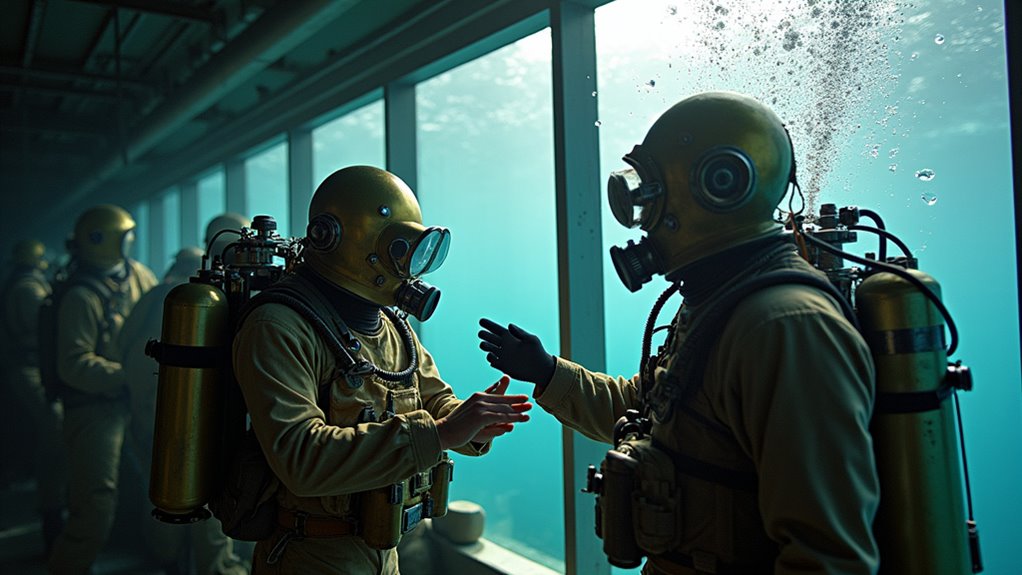
While Leonardo’s designs remained theoretical, warfare created the urgent need that transformed diving from sketches into reality. You’ll find that military necessity consistently pushed diving technology forward throughout history.
During World War I, naval forces desperately needed underwater saboteurs and ship repair capabilities. This drove rapid innovation in breathing apparatus and diving suits.
You can trace modern scuba’s DNA directly to military frogmen programs. Italian navy divers developed closed-circuit rebreathers for stealth missions, while British commandos refined underwater demolition techniques.
The famous Aqua-Lung, invented by Jacques Cousteau and Émile Gagnan in 1943, actually emerged from French resistance needs during Nazi occupation.
Military diving schools became testing grounds where life-or-death situations demanded reliable equipment. What you use today for recreation was forged in wartime urgency.
Just as military divers needed protection from underwater threats, soldiers in tropical combat zones required mosquito nets to guard against disease-carrying insects that could compromise mission effectiveness.
Beyond the battlefield, treasure hunters and salvage crews faced their own underwater challenges that demanded different solutions. You’ll find that commercial salvagers needed equipment that could withstand longer dives and harsher conditions than military gear. They developed stronger air hoses, more reliable regulators, and deeper diving capabilities to reach sunken ships and valuable cargo.
These profit-driven operations pushed manufacturers to create more durable equipment. Salvage crews couldn’t afford equipment failures when thousands of dollars in treasure hung in the balance. They demanded gear that worked consistently in saltwater environments and extreme depths.
Their requirements led to innovations in dive suits, air delivery systems, and underwater communication devices. Commercial salvage operations fundamentally became testing grounds for civilian diving equipment, driving improvements that eventually benefited recreational divers worldwide. Just as parents must carefully evaluate camping gear for their children’s safety and durability needs, salvage operators had to scrutinize every piece of equipment before trusting it in high-stakes underwater operations.
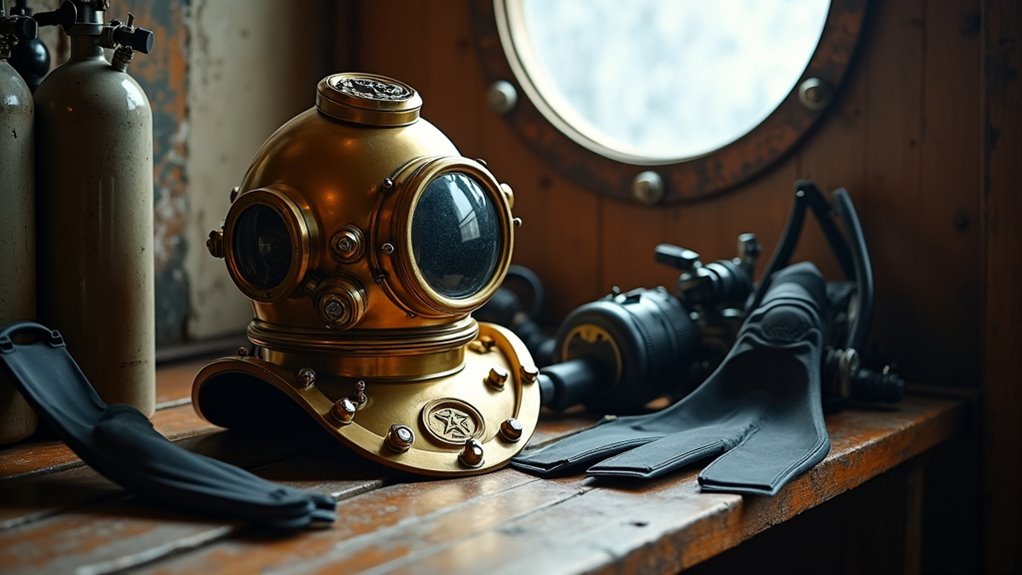
As commercial diving operations proved the viability of underwater work, inventors began tackling diving’s biggest limitation: dependence on surface air supplies. You’ll find that early attempts at self-contained breathing apparatus date back to the 1860s, but most proved impractical or dangerous.
The breakthrough came in 1943 when Jacques Cousteau and Émile Gagnan developed the Aqua-Lung, featuring an automatic demand regulator that delivered air only when you inhaled. This innovation eliminated the constant air flow that wasted precious breathing gas in earlier designs.
You’d now have complete freedom underwater without worrying about air hoses getting tangled or cut. The Aqua-Lung’s success launched recreational diving and transformed underwater exploration from professional necessity into popular adventure sport. Just as modern adventurers might take a break from traditional camping to explore backpacking across diverse landscapes, early divers could now venture away from their surface-tethered limitations to discover new underwater territories.
Following World War II’s end, military divers returned home with invaluable underwater experience and a desire to continue exploring beneath the waves. You’ll find that these veterans became diving’s first ambassadors, sharing their skills with curious civilians. They established dive clubs, taught safety protocols, and organized underwater expeditions along coastlines.
By the 1950s, you’d see diving shift from military necessity to recreational pursuit. Equipment manufacturers recognized this growing market, making gear more accessible and affordable for everyday enthusiasts. Dive shops opened in coastal communities, offering training courses and equipment rentals.
You can trace modern recreational diving’s roots to this pivotal decade when former military personnel transformed their wartime expertise into peacetime passion, creating the foundation for today’s global diving community and establishing safety standards still used today. Just as camping enthusiasts require essential sleeping gear for comfortable nights outdoors, these early recreational divers needed proper equipment to safely explore underwater environments.
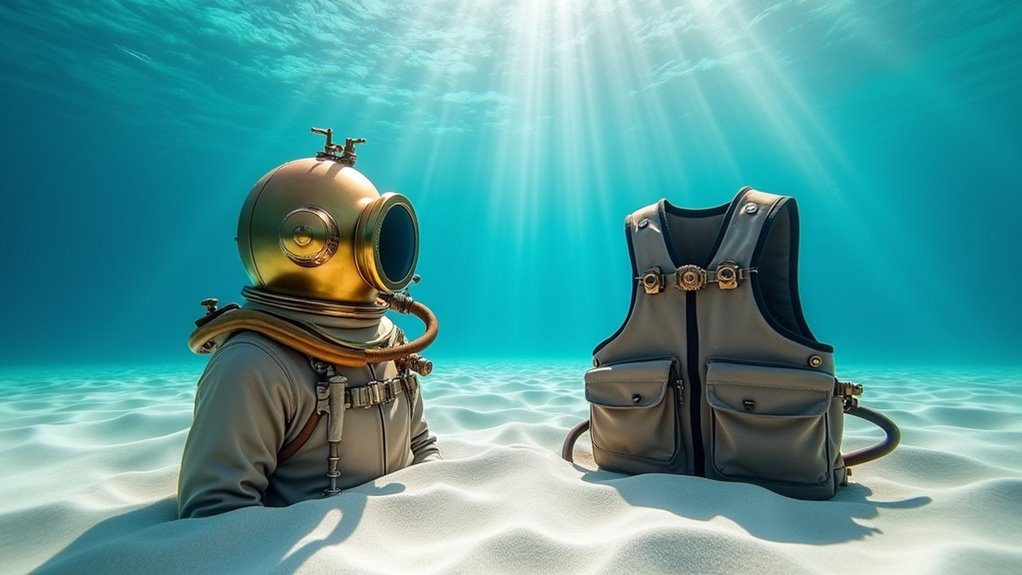
While those early recreational divers relied on basic gear adapted from military surplus, today’s scuba equipment represents decades of technological advancement and rigorous safety testing. You’ll find modern diving gear incorporates sophisticated materials and engineering that would’ve seemed impossible to Jacques Cousteau’s generation.
Modern scuba gear showcases engineering breakthroughs that would have amazed diving pioneers like Jacques Cousteau just decades ago.
Today’s safety standards reflect hard-learned lessons from decades of diving incidents. Organizations like PADI and NAUI established exhaustive training protocols that’ve dramatically reduced accident rates.
Modern equipment includes:
You’re diving in an era where equipment reliability and diver education have reached unprecedented levels of sophistication. Just as RV enthusiasts are embracing eco-friendly living practices on the road, the diving community has increasingly adopted sustainable approaches to protect marine environments.
You’ve journeyed through scuba diving’s incredible transformation from ancient pearl divers holding their breath for impossibly long minutes to today’s high-tech gear that’ll keep you breathing underwater like a fish. This rich history isn’t just trivia—it’s shaped every piece of equipment you’ll use and safety protocol you’ll follow. Understanding these roots connects you to generations of underwater explorers and reminds you that you’re part of an ongoing adventure that spans cultures and centuries.